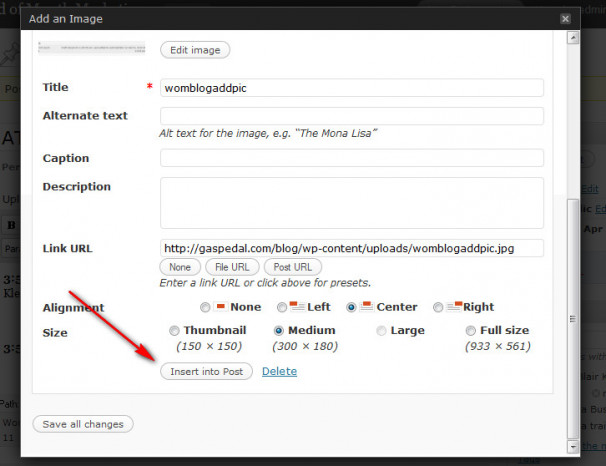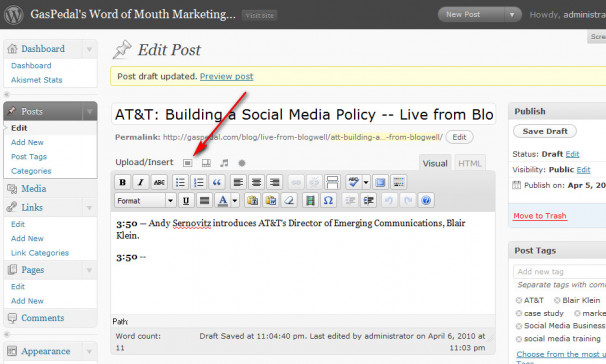3:49 – Andy Sernovitz introduces Blair Klein, Director of Emerging Communications at AT&T
3:50 – Blair sets the expectation that she won’t be as funny as Andy 😉
3:50 – Everyone feels that they are far behind in using social media. AT&T still problems and issues that they are dealing with. Everyone is learning so don’t be intimidated.
3:51 – AT&T in 2007 started seeing social media growing organically. There was an internal platform called tSpace – for social media activity internally – blogs, wikis and bookmarks. Then they realized that they need to have a policy and process for the stakeholders.
3:52 – The first step was to bring in all of the stakeholders. Before you engage in this think about your organization and where your unique challenges and opportunities are. What is the level of trust and what type of social media is appropriate (wikis, microblog, blog, etc)?
3:53 – Consider creating a task force. What are the actual needs of your business to execute? Include both your allies and the nay-sayers. Lay out the low hanging fruit for your organization.
3:54 – Demonstrate how other companies are using social media – Collect other learnings and mistakes and policies. Also, be sure to include legal up-front. The FTC guidelines are serious and there are legitimate legal concerns.
3:55 – AT&T did a “blog trial” with a forum and two blogs to run a statistically significant test with external monitoring to provide real information around blogging and social media. This was time consuming but gave us the green light to move forward.
3:56 – AT&T Social Media Policy Highlights – Consider other standards vs. creating a totally new set of standards. Key Highlights: All Code of Conduct applies in social media, No anonymous posts, Views are your own and not official, Have a Business Purpose for Posting, Discipline for violations are clear, Don’t disclose confidential info, Don’t disparage competitors, customers, coworkers, suppliers, etc.
3:58 – This allowed AT&T to create social media 1.0 – On October 31, 2008 by allowing comments. This was only the first step.
3:59 – In the last year and a half AT&T created a crowdsourced platform called The Innovation Pipeline which is a patentable idea funnel. Anyone in the company can submit an idea and the wisdom of the crowd helps to decide which ideas should move forward. There are about a dozen that have come out of this. There are rewards and incentives for employees. There are over 28,000 participants.
4:01 — tSpace is the AT&T social media platform and it includes employee profiles, community pages, blogs, wikis, bookmarks and newfeeds. There are 23,223 wiki pages in 1,197 wiki spaces, 113 blogs (leadership, postulation and recognition), 103 communities.
4:03 – AT&T external use – all customer focused companies need to have a customer care department. Your advertising messages are pointless if customers can’t get help. There is a social media customer care team that works in Twitter and Facebook to help solve problems. They are also active on youtube to share videos for common questions.
4:05 – Don’t overlook the BtoB opportunities. 35 – 54 year old’s are growing in their social media use which means that the BtoB opportunities are growing.
4:06 – AT&T is using social media for social recruiting. They have launched a Facebook app called “Work with me” and are also active on twitter and other social sites.
4:07 – Participation is what buys you the credibility in social media. If you build it they may not come. Find the voices that you want to interact with and participate. They aren’t going to find you just because you are there. It isn’t just a one-way street.
4:08 – The grace period is ending and the expectations from customers are growing. They expect you to respond in social media. They also know that they can be publicly heard.
4:09 – There isn’t enough time to go into location based opportunities, however this is a great opportunity area beyond what we are seeing right now. As companies start to figure this out we can expect to see great things here.
Q/A
Q: When you started your social media testing you were going through a lot of mergers and acquisitions. How did you leverage social media to integrate new employees?
A: We were really still struggling with our internal policy and procedure so we didn’t really leverage social media as much as we could have. We didn’t really do much – there was some organic activity on tSpace, but it wasn’t a key communications strategy.
Q: With so many employees on the internal social network, how do you handle security?
A: AT&T has a global login and a central security group. They built it inside the Firewall to be secure.
Q: Did the Facebook job app move the needle?
A: The social recruiting team spent $100 on twitter which has resulted in 5,000 applications. The social recruiting efforts puts “butts in the seats” which is key given the turnover and recruiting efforts.
Q: How do you work with terms of service on social sites?
A: We look closely at terms of service and we abide by them. When we created the Facebook presence Facebook didn’t have an official way for companies to participate. Social networks will change over time and may begin to have costs associated with them. If you aren’t prepared to pay, consider whether or not you should build a presence there.
Q: Did AT&T have a plan about how to drop an official spokesperson?
A: There was an official quiet strategy to deal with this. There isn’t a lot that Blair can share about this. They are excited about the Masters – Please watch tomorrow!




